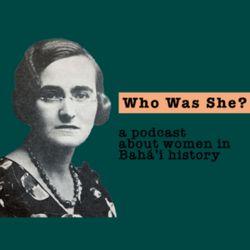Latest episode

9. Bonus episode! BTS on Carole Lombard!
44:06||Season 4, Ep. 9A conversation with host Tara and her friend, Angie. Learn how this podcast season came about, the challenges, the creative process, and the people who helped make this season! We have a website! https://www.podpage.com/whowasshepodcast/You can also find more information on our social media:http://instagram.com/whowasshepodcasthttps://www.facebook.com/whowasshepodcasthttps://www.pinterest.com/whowasshepodcastOur music composer, Sam Redd is on SoundCloud as "Sam Redd": https://soundcloud.com/samreddand YouTube as @SammyManhattan: https://www.youtube.com/@sammymanhattanSubscribe on your favorite podcast platform: https://pod.link/1548368026
More episodes
View all episodes

8. It's Been An Honor
18:49||Season 8, Ep. 8In our last episode of the season, we find out the challenges of Carole's love story with Clark Gable, her connections to some familiar names, her efforts to help during World War II, and her untimely death.We have a website! https://www.podpage.com/whowasshepodcast/You can also find more information on our social media:http://instagram.com/whowasshepodcasthttps://www.facebook.com/whowasshepodcasthttps://www.pinterest.com/whowasshepodcastOur music composer, Sam Redd is on SoundCloud as "Sam Redd": https://soundcloud.com/samreddand YouTube as @SammyManhattan: https://www.youtube.com/@sammymanhattanSubscribe on your favorite podcast platform: https://pod.link/1548368026
7. The Greatest Love Story
13:46||Season 4, Ep. 7How did Carole and Clark Gable finally become a couple? Why does "Gone with the Wind" have anything to do with it? Find out in the latest episode! We have a website! https://www.podpage.com/whowasshepodcast/You can also find more information on our social media:http://instagram.com/whowasshepodcasthttps://www.facebook.com/whowasshepodcasthttps://www.pinterest.com/whowasshepodcastOur music composer, Sam Redd is on SoundCloud as "Sam Redd": https://soundcloud.com/samreddand YouTube as @SammyManhattan: https://www.youtube.com/@sammymanhattanSubscribe on your favorite podcast platform: https://pod.link/1548368026
6. Her Greatest Heartbreak
08:09||Season 4, Ep. 6Two major deaths occur that impact Carole's life, which drives her to work harder in Hollywood. We have a website! https://www.podpage.com/whowasshepodcast/You can also find more information on our social media:http://instagram.com/whowasshepodcasthttps://www.facebook.com/whowasshepodcasthttps://www.pinterest.com/whowasshepodcastOur music composer, Sam Redd is on SoundCloud as "Sam Redd": https://soundcloud.com/samreddand YouTube as @SammyManhattan: https://www.youtube.com/@sammymanhattanSubscribe on your favorite podcast platform: https://pod.link/1548368026
5. The Studios Trading Girl
11:45||Season 4, Ep. 5In this episode, Carole grows in her career, building her reputation as the comedic actress in Hollywood, working with major studios like Paramount and Columbia, making seven films back to back in one year, navigating a failing marriage, and much more!We have a website! https://www.podpage.com/whowasshepodcast/You can also find more information on our social media:http://instagram.com/whowasshepodcasthttps://www.facebook.com/whowasshepodcasthttps://www.pinterest.com/whowasshepodcastOur music composer, Sam Redd is on SoundCloud as "Sam Redd": https://soundcloud.com/samreddand YouTube as @SammyManhattan: https://www.youtube.com/@sammymanhattanSubscribe on your favorite podcast platform: https://pod.link/1548368026
4. Mrs. Carole Powell
10:33||Season 4, Ep. 4Carole gets married, becomes the favorite client for the infamous talent agent, Myron Selznick, and holds her own against Harry Cohen, aka "The most hated man in Hollywood," plus much more! We have a website! https://www.podpage.com/whowasshepodcast/You can also find more information on our social media:http://instagram.com/whowasshepodcasthttps://www.facebook.com/whowasshepodcasthttps://www.pinterest.com/whowasshepodcastOur music composer, Sam Redd is on SoundCloud as "Sam Redd": https://soundcloud.com/samreddand YouTube as @SammyManhattan: https://www.youtube.com/@sammymanhattanSubscribe on your favorite podcast platform: https://pod.link/1548368026
3. The Orchid Lady
07:06||Season 4, Ep. 3In the third episode of this new season, we follow Lombard's transformation from a struggling actress to becoming Paramount Pictures' "Orchid," how she earned the respect of Hollywood, and more! We have a website! https://www.podpage.com/whowasshepodcast/You can also find more information on our social media:http://instagram.com/whowasshepodcasthttps://www.facebook.com/whowasshepodcasthttps://www.pinterest.com/whowasshepodcastOur music composer, Sam Redd is on SoundCloud as "Sam Redd": https://soundcloud.com/samreddand YouTube as @SammyManhattan: https://www.youtube.com/@sammymanhattanSubscribe on your favorite podcast platform: https://pod.link/1548368026
